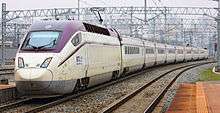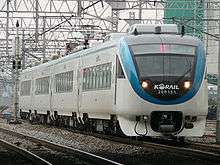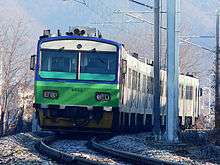Korail
 | |
|
Headquarters of Korea Railroad Corporation | |
| State-owned enterprise | |
| Industry | |
| Founded |
September 1, 1963 as Korean National Railroad January 1, 2005 split into Korail and KR |
| Headquarters | Soje-dong, Dong-gu, Daejeon, South Korea |
| Products | Railroad and subway transportation |
|
| |
|
| |
| Website | info.korail.com letskorail.com |
| Korea Railroad | |
|---|---|
| Operation | |
| Infrastructure company | KR |
| Statistics | |
| Ridership | 969,145,101[2] |
| Passenger km | 31,415,965,207[2] |
| Freight | 10,553,675,728 ton km[2] |
| System length | |
| Total | 3,558.9 kilometres (2,211.4 mi) |
| Double track | 1,865.3 kilometres (1,159.0 mi) |
| Electrified | 2,356.7 kilometres (1,464.4 mi) |
| High-speed | 368.5 kilometres (229.0 mi) |
| Track gauge | |
| Main | 1,435 mm (4 ft 8 1⁄2 in) |
| High-speed | 1,435 mm (4 ft 8 1⁄2 in) |
| Electrification | |
| AC 25,000V 60Hz | 2,337.5 kilometres (1,452.5 mi) |
| DC 1,500V | 19.2 kilometres (11.9 mi) |
| Features | |
| No. stations | 652 |
| Highest elevation | 855 metres (2,805 ft) |
| at | 37°12′0″N 128°56′59.83″E / 37.20000°N 128.9499528°E |
| Korail | |
| Hangul | 한국철도공사 |
|---|---|
| Hanja | 韓國鐵道公社 |
| Revised Romanization | Hanguk cheoldo gongsa |
| McCune–Reischauer | Han’guk ch'ŏlto kongsa |
.jpg)










Korea Railroad Corporation (Korean: 한국철도공사, Hanja: 韓國鐵道公社), promoted as Korail (코레일), is the national railroad operator in South Korea.
Korail operates commuter, subway, intercity and freight trains throughout South Korea. The railroad's headquarters are located in Daejeon.
History
What is now known as Korail was started as Railroad Administration Bureau of the Ministry of Transportation with the establishment of South Korean government. On September 1, 1963, the bureau became an agency that was known as Korean National Railroad (KNR) in English. In 2003, KNR adopted the current "Korail" logo in blue, but the "Korail" name was adopted before 2003. On January 1, 2005, KNR was split into Korea Railroad Corporation, which succeeded railroad operation with the Korail logo and name, and Korea Rail Network Authority, which succeeded maintaining tracks. In 2007, Corporate identity combining regarding 'Korail" was officially ended. In 2013 Dr. Choi YeonHye was appointed as the first female president and CEO of Korail.[3]
Lines
Korail operates all the long distance lines in South Korea as well as local lines. The Gyeongbu Line with its high-speed parallel line, running between the two largest cities, Seoul and Busan, is by far the most heavily travelled line. Other main lines include Honam Line and Jeolla Line, stretching into Jeolla region, the Janghang Line and the Jungang Line.
The South Korean government plans to invest $US 88 billion in the network from 2011 to 2020, with extensive double-tracking and electrification.[4]
The current list of railway lines with regular passenger service is as follows (urban Seoul metro lines excepted):
- Gyeongbu Line 경부선 : Seoul-Busan. Fully electrified double track.
- Gyeongbu High-speed Line 경부고속선 : Seoul-Busan (Seoul-Daejeon and Okcheon-Chilgok in first phase). Fully electrified double track high speed.
- Honam Line 호남선 : Daejeon-Mokpo. Fully electrified double track.
- Honam High-speed Line 호남고속선 : Osong-Gwangju Songjeong. Fully electrified double track high speed.
- Gwangju Line 광주선 : Gwangju Songjeong-Gwangju main station. Fully electrified single track branch line, for KTX and intercity services into central Gwangju.
- Jeolla Line 전라선 : Iksan-Yeosu. Fully electrified double track.
- Janghang Line 장항선 : Cheonan-Iksan. This line formerly ended at Janghang station, but extended into Iksan when the bridge between Janghang and Gunsan was completed in December 2008. Former Janghang and Gunsan lines consolidated into new Janghang Line.
- Gyeongchun Line 경춘선 : Seoul-Chuncheon. Fully electrified line reopened in 2010.
- Jungang Line 중앙선 : Seoul-Gyeongju. Partially electrified double track.
- Chungbuk Line 충북선 : Jochiwon-Jecheon. Fully electrified double track. This line links Gyeongbu and Jungang main lines and therefore plays a great role in freight transport.
- Yeongdong Line 영동선 : Yeongju-Gangneung. Partly electrified. The most mountainous route in Korea.
- Taebaek Line 태백선 : Jecheon-Cheolam. Fully electrified, as a shortcut leading to Gangneung.
- Jeongseon Line 정선선 : Jeungsan-Auraji. It is famous as a scenic route, but was originally built for coal mining.
- Gyeongbuk Line 경북선 : Gimcheon-Yeongju.
- Daegu Line 대구선 : Daegu-Yeongcheon.
- Donghae Nambu Line 동해남부선 : Pohang-Busan.
- Gyeongjeon Line 경전선 : Gwangju-Samnangjin. This line stretches along the southern coast and links Jeolla and Gyeongsang regions. Usually, this line is regarded as a set of branch lines, which feed local traffic into adjacent major lines.
- Gyeongui Line 경의선 : Munsan-Dorasan (near DMZ).
- Gyeongwon Line 경원선 : Soyosan-Sintan-ri (near DMZ)
The above two lines were country's main lines before division, but after division, only local trains have been in service. Now these two lines are almost regarded as metro lines, with Tonggeun (Commuter) services in some sections.
Urban Railway lines
In addition to conventional long-distance passenger and freight services, Korail also operates the following metro and commuter rail lines connected to the Seoul Metropolitan Subway:
- Gyeongin Line (1900- ) - conventional rail; 경인선 (Guro-Incheon); 구로-인천 is connected with Line 1
- Seoul Subway Line 4: Ansan Line (1988- ) - conventional rail; 안산선 (Geumjeong-Oido); 금정-오이도 is connected with Line 4
- Seoul Subway Line 4: Gwacheon Line (1994- ) - underground; 과천선 (Seonbawi-Geumjeong); 선바위-금정 is connected with Line 4
- Bundang Line (1994- ) - underground; 분당선 (Wangsimni-Suwon); 왕십리-수원
- Seoul Subway Line 3: Ilsan Line (1996- ) - partially underground; 일산선 (Jichuk-Daehwa); 지축-대화 is connected with Line 3 (This line employs DC 1,500V only.)
Also, the following portions of the conventional lines listed below are linked with sections of Seoul Subway Line 1 and Jungang Line, with portions that share tracks with other types of rail:
- Gyeongwon Line; 경원선 (Soyosan-Hoegi); 소요산-회기 is connected with Line 1 and (Cheongnyangni-Yongsan); 청량리-용산 is part of the Jungang Line
- Gyeongbu Line; 경부선 (Namyeong-Cheonan); 남영-천안 is connected with Line 1
- Janghang Line; 장항선 (Cheonan-Sinchang); 천안-신창 is connected with Line 1
- Jungang Line; 중앙선 (Cheongnyangni-Yongmun); 청량리-용문 is part of the Jungang Line
- Gyeongui Line; 경의선 (Seoul Station-Munsan); 서울-문산 is part of the Gyeongui Line
Korail covers a total of 104 stations with its 150 trains. The operation intervals are from 1.7 to 8 minutes during rush hours and 3.6 to 15 minutes during non-rush hours. An average of 2,177,000 people use Korail's commuter lines every day.
Train classes
The highest level of Korail trains is KTX (Korea Train Express). KTX trains run along Gyeongbu Line and Honam Line. ITX (Intercity Train Express), introduced in February 2012, runs along non-HSR lines and have more stops. As of August 2014, there are two ITX services available; ITX-Cheongchun (ITX-청춘) on Gyeongchun Line, and ITX-Saemaul (ITX-새마을) on Gyeongbu, Jungang, and Honam Line.
Saemaul-ho (새마을호), which borrowed its name from New Community Movement, provides the fastest and most comfortable service in selected conventional rail lines. After ITX-Saemaul service introduced, Saemaul-ho service will gradually replaced with new ITX service and only non-electrified service will remain as Saemaul class.
Mugunghwa-ho (무궁화호), the most popular grade, is most popular in Korail service order. Almost every rail line has one or more regular Mugunghwa-ho schedule, mainly express but also including one or more local services. Nuriro (누리로) service, introduced in June 2009, is medium- to long-distance service similar to German RegionalExpress. Nuriro service mainly runs between Seoul and Sinchang and placed between Seoul Subway and Mugunghwa-ho.
Commuter(통근열차) is low-cost metropolitan area commuter service, operated with diesel multiple units (DMU).
Tourist Trains
Korail has a number of tourist or sightseeing trains, including the Sea Train, DMZ Train, O-Train, V-Train, S-Train, A-Train, and G-Train.[5]
Major stations
- Seoul/Gyeonggi : Seoul, Yongsan, Gwangmyeong, Noryangjin, Yeongdeungpo, Guro, Suwon, Incheon (Seoul Metro Line 1), Incheon International Airport (KTX, AREX), Cheongnyangni, Uijeongbu, Deokso, Bupyeong, Dongducheonjungang
- Gangwon : Chuncheon, Wonju, Donghae, Gangneung, Jeongdongjin
- Chungcheong : Cheonan, Cheonan-Asan, Jochiwon, Sintanjin, Daejeon, Seodaejeon, Janghang, Jecheon, Cheongju, Chungju
- Jeolla : Iksan, GwangjuSongjeong, Gwangju, Mokpo, Gunsan, Jeonju, Suncheon, Yeosu EXPO
- Gyeongsang : Gimcheon, Daegu, Dongdaegu, Samnangjin, Busanjin, Busan, Andong, Yongju, Gyeongju, Pohang, Ulsan, Changwon, Gimhae, Jinhae, Masan, Jinju
Rail passes
Korail offers a rail pass called Korea Rail Pass, or KR Pass for short, to foreign travelers, such that they can take most of the trains operated by Korail freely, including KTX. But subways and tourist trains by Korail are not covered.[6]
Foreigners living in South Korea for more than six months are ineligible for using KR Pass, but Korail offers the Happy Rail Pass, which is very similar to the KR Pass, for a slightly a higher price.[6]
Korail also issues a Korea-Japan Joint Ticket jointly with JR Group, covering both railways in South Korea and Japan, as well as a high-speed ferry trip between Korea and Japan (Fukuoka/Busan). However, the pass is not valid for KTX, and the holders need to buy an extra ticket (though with a 30% discount).[6]
JR Kyushu also offers a KR Pass (inclusive of KTX) and high-speed ferry package (Fukuoka/Busan).[7]
Labour relations
Most of the railroad's employees are members of the Korean Railway Workers' Union, which is frequently at odds with Korail management. Strikes, such as the South Korean railroad strike of 2006, are not uncommon.
In December 2013, 23,000-100,000 union members and friends protested the privatization of Korail in Seoul.[8]
Subsidiaries
- Korail Airport Railroad, which operates A'REX.
- Korail Networks, for ticketing management and Korail frequent riders program.
- Korail Retail, for advertisement management and running "Storyway" convenience store.
- Korail Tour Service, for KTX/Saemaul-ho train crew and travel service.
Locomotives and rolling stock on KORAIL lines
International service
Until the division of Korea following the end of the Second World War, the Gyeongui Line and Gyeongwon Line extended into what is now North Korea. The Gyeongui Line connected Seoul to Kaesong, Pyongyang, and Sinuiju on the Chinese border, while the Gyeongwon Line served Wonsan on the east coast. Another line—the Kumgang-san Line—connected the town of Cheorwon, now on the border of North and South Korea, on the Gyeongwon Line, to Mt. Geumgang, now in the North.
The Gyeongui Line is one of two lines whose southern and northern halves are now being reconnected, the other line being the Donghae Bukbu Line. On 17 May 2007, two test trains ran on the reconnected lines: one on the west line from Munsan to Kaesong; the second on the east from Jejin to Kumgang.[9]
In December 2007, regular freight service started on the Gyeongui line, from South Korea into the Kaesong Industrial Park in the north. The service has been underutilized, however: as it was reported in October 2008, on 150 out of 163 return trips that had been done so far, the train carried no cargo at all. The total amount of cargo carried over this period had been merely 340 tons. This absence of interest in the service has been explained by the customers' (companies operating in Kaesong) preference for road transport.[10] In November 2008, North Korea shut down the link.
A Trans-Korean Main Line, spanning North Korea and connecting to Russian Railways, is planned.[11]
There is no railroad connection between South Korea and Japan
Japan Rail Kyushu offers a jet foil ferry service between Busan and Fukuoka taking about 3 hours.
Korail and Japan Rail West also have a joint rail pass (called 한일공동승차권) which includes discounted KTX and Shinkansen ticket with Busan-Shimonoseki/Fukuoka ferry ticket.
A Korean Strait undersea tunnel was proposed from Fukuoka to Busan via Tsushima as far back as 1917, but the plan has never progressed past the research phase. While the increased wealth of South Korea and continued growth of trade between the nations has made the economic case for the tunnel more compelling, promotion has focused more on using the project to reduce political tension between the nations.[12]
See also
- List of Korea-related topics
- List of suburban and commuter rail systems
- Choson Cul Minzuzui Inmingonghoagug - aka Korean State Railway, North Korea's national rail operator
- Incheon Korail FC, Korea National League football team.
- Korea Rail Network Authority
- KTX Family Card, frequent riders program
- Transportation in South Korea
References
- 1 2 "2010 Statements of Income". Korail. Retrieved 2013-05-28.
- 1 2 3 "KOSIS 국가통계포털".
- ↑ David Briginshaw. "Korail appoints its first female president and CEO".
- ↑ http://www.railjournal.com/newsflash/korea-plans-us-88-billion-ten-year-investment.html
- ↑ Lee, Sun-Min (January 24, 2015). "Planned G-Train offers tourists ultimate comfort". JoongAng Ilbo. Retrieved February 27, 2015.
- 1 2 3 "Official Site of Korea Tourism Org.: Railroad Passes".
- ↑ "コリアレール&ビートルパス|BEETLE".
- ↑ "[現場] 寒波の中 10万の人波 「国民を敵に回すな」".
- ↑ "Korean trains in historic link-up". BBC News. 2007-05-17. Retrieved 2007-05-17.
- ↑ Richard Spencer (23 Oct 2008). "Korean detente railway becomes ghost train". The Daily Telegraph. London.
- ↑ "Trans-Korean Main Line - Investment in the Future - Russian Transport Daily Report". 2010-10-29. Retrieved 2010-10-30.
- ↑ Cazzaniga, Pino (October 13, 2009). "Japan and South Korea Increasingly Closer: The Two Nations Are Now Planning The Future Together: An Underwater Tunnel, A Common History Book...". Japan: AsiaNews.it. Retrieved December 4, 2009.
External links
| Wikimedia Commons has media related to Korea Railroad. |
